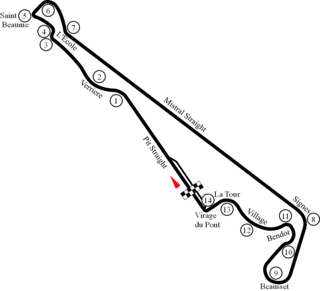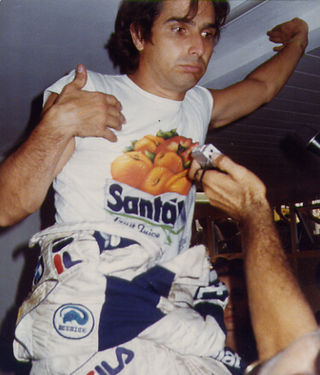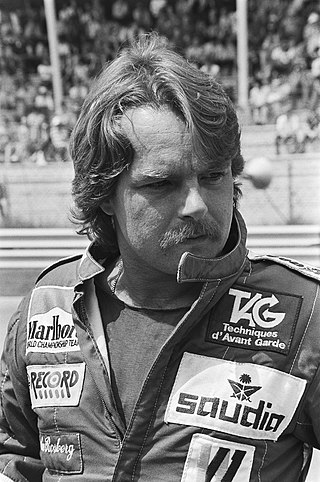
Nelson Piquet Souto Maior is a Brazilian retired racing driver and businessman who won the World Drivers' Championship three times in the years 1981, 1983 and 1987.

The British Grand Prix is a Grand Prix motor racing event organised in the United Kingdom by Motorsport UK. First held by the Royal Automobile Club (RAC) in 1926, the British Grand Prix has been held annually since 1948 and has been a round of the FIA Formula One World Championship every year since 1950. In 1952, following the transfer of the lease of the Silverstone Circuit to the British Racing Drivers' Club, the RAC delegated the organisation of races held at Silverstone to the BRDC, and those held at Aintree to the British Automobile Racing Club. This arrangement lasted until the RAC created the Motor Sports Association in the late 1970s and it reclaimed organising control of the event. The RAC MSA was renamed Motorsport UK in 2019 when it formally split from the RAC.

The Austrian Grand Prix is a Fédération Internationale de l'Automobile sanctioned motor racing event that was held in 1964, 1970–1987, 1997–2003, and then returned to the Formula One calendar in 2014.

The 1983 South African Grand Prix was a Formula One motor race held at Kyalami on 15 October 1983. It was the fifteenth and final race of the 1983 Formula One season. The 77 lap race was won by Riccardo Patrese driving for Brabham. This would be Patrese's last win for nearly seven years until he won for Williams at the 1990 San Marino Grand Prix.

The 1984 South African Grand Prix was a Formula One motor race held at Kyalami on 7 April 1984. It was race 2 of 16 in the 1984 Formula One World Championship. The 75-lap race was won by Niki Lauda, driving a McLaren-TAG, with teammate Alain Prost second and Derek Warwick third in a Renault.

The 1984 Belgian Grand Prix was a Formula One motor race held at Circuit Zolder on 29 April 1984. It was the third race of the 1984 Formula One World Championship. It was the 42nd Belgian Grand Prix, and the tenth and last to be held at Zolder. The race was held over 70 laps of the 4.26-kilometre (2.65 mi) circuit for a race distance of 298.3 kilometres (185.4 mi).

The 1984 Dallas Grand Prix was a Formula One motor race held on July 8, 1984 at Fair Park in Dallas, Texas. It was the only running of the Dallas Grand Prix as a Formula One race, and the ninth race of the 1984 Formula One World Championship.

The 1985 French Grand Prix was a Formula One motor race held at Paul Ricard on 7 July 1985. It was the seventh race of the 1985 Formula One World Championship. It was the 63rd French Grand Prix and the ninth to be held at Paul Ricard. The race was held over 53 laps of the 5.81-kilometre (3.61 mi) circuit for a total race distance of 307.93 kilometres (191.34 mi).

The 1985 British Grand Prix was a Formula One motor race held at Silverstone on 21 July 1985. It was the eighth race of the 1985 Formula One World Championship.

The 1985 Austrian Grand Prix was a Formula One motor race held at Österreichring on 18 August 1985. It was the tenth race of the 1985 Formula One World Championship. It was the 25th Austrian Grand Prix and the 24th to be held at Österreichring. The race was run over 52 laps of the 5.94-kilometre (3.69 mi) circuit for a total race distance of 308.9 kilometres (191.9 mi).

The 1985 South African Grand Prix was a Formula One motor race held on 19 October 1985 at the Kyalami Circuit in South Africa. It was the fifteenth and penultimate round of the 1985 FIA Formula One World Championship.

The 1986 FIA Formula One World Championship was the 40th season of FIA Formula One motor racing. It featured the 1986 Formula One World Championship for Drivers and the 1986 Formula One World Championship for Manufacturers, both of which commenced on 23 March and ended on 26 October after sixteen races. The Drivers' Championship was won by Alain Prost, Prost was the first driver to win back-to-back Drivers' Championships since Jack Brabham in 1959 and 1960. Together with Prost, Nigel Mansell, Nelson Piquet and Ayrton Senna dominated throughout the season and formed what was dubbed as the "Gang of Four".

The 1985 FIA Formula One World Championship was the 39th season of FIA Formula One motor racing. It featured the 1985 Formula One World Championship for Drivers and the 1985 Formula One World Championship for Manufacturers, both of which commenced on 7 April and ended on 3 November after sixteen races.

The 1984 FIA Formula One World Championship was the 38th season of Fédération Internationale de l'Automobile (FIA) Formula One motor racing. It featured the 1984 Formula One World Championship for Drivers and the 1984 Formula One World Championship for Manufacturers, both of which commenced on 25 March and ended on 21 October after sixteen races.

The 1983 FIA Formula One World Championship was the 37th season of FIA Formula One motor racing. It featured the 1983 Formula One World Championship for Drivers and the 1983 Formula One World Championship for Manufacturers, which were contested concurrently over a fifteen-race series that commenced on 13 March and ended on 15 October.

The 1982 FIA Formula One World Championship was the 36th season of FIA Formula One motor racing. It included two competitions run over the course of the year, the 33rd Formula One World Championship for Drivers and the 25th Formula One World Championship for Constructors. The season featured sixteen rounds between 23 January and 25 September. The Drivers' Championship was won by Keke Rosberg and the Constructors' Championship by Scuderia Ferrari.

The 1981 FIA Formula One World Championship was the 35th season of FIA Formula One motor racing. It featured the 1981 Formula One World Championship for Drivers and the 1981 Formula One World Championship for Manufacturers, which were contested over a fifteen-race series that commenced on 15 March and ended on 17 October. The 1981 South African Grand Prix, as a non-championship race due to difficulties from the ongoing FISA–FOCA war, was open to Formula One entrants but was not part of the World Championship.

The 1980 Formula One season was the 34th season of FIA Formula One motor racing. It featured the 1980 World Championship of Drivers and the 1980 International Cup for F1 Constructors, which were contested concurrently from 13 January to 5 October over a fourteen-race series. The season also included one non-championship race, the Spanish Grand Prix.

The Dutch Grand Prix is an annual Formula One World Championship auto racing event, held at Circuit Zandvoort, North Holland, the Netherlands, from 1950 through 1985, and after a 35 year hiatus, from 2021 onwards.

The McLaren MP4/2 was a Formula One car produced by McLaren for the 1984 season. An iteration of it, the MP4/2B, was used in the 1985 season, and a slightly updated version, the MP4/2C, raced in the 1986 season for McLaren. It was closely based on the MP4/1E model that was used as a test car, used in the final races of 1983.




















